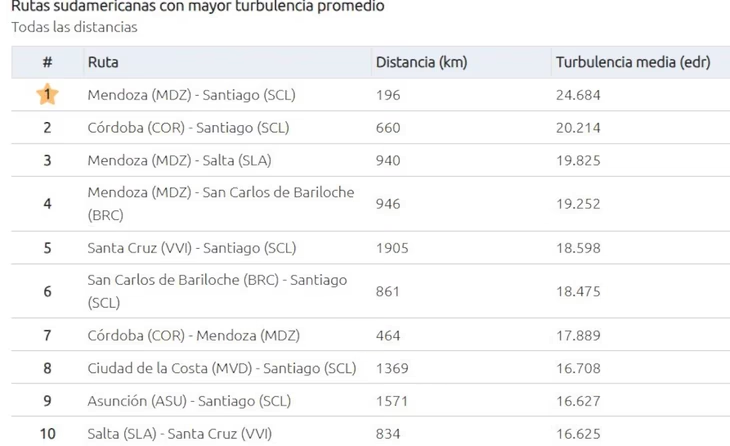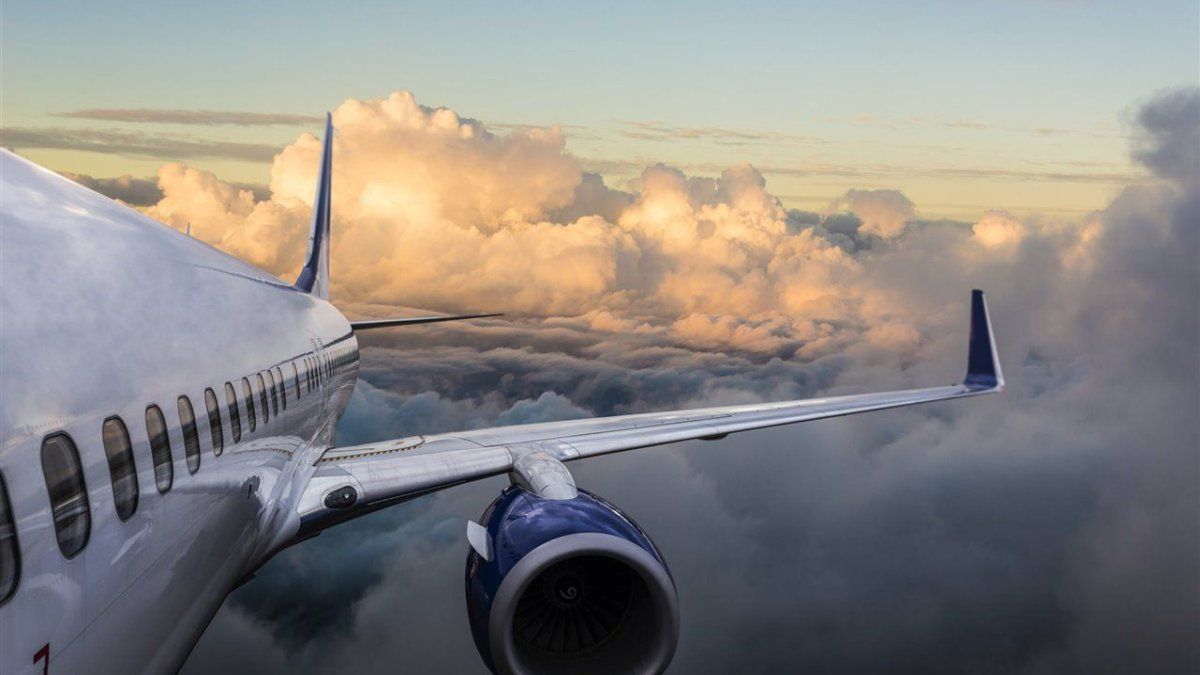The web platform Turblispecialized in measuring turbulencelaunched a new edition of its annual ranking of the world’s most turbulent air routes. In it, Argentina has a clear role since It has five sections on the list.
To obtain the report, a survey of approximately 10,000 routes that link more than 500 airports in the world is carried out, taking as reference the data collected by the United States National Oceanic and Atmospheric Administration (NOAA) and the UK Met Office.
Likewise, for the process of forming the ranking Turbli uses eddy dissipation rates (EDR), which measure the intensity of turbulence at a given point, on a scale from 0 to 100 and with the following levels: light from 0 to 20; moderate 20 to 40; severe from 40 to 80; and extremes from 80 to 100.
The ranking of the 10 air routes with the greatest turbulence in the world
routes ranking.avif
The list ordered the 10 routes with the greatest turbulence in the world.
Among the 10 sections proposed by the web platform, five sections appear with Argentine cities in between. The first, which leads the ranking, is the route that connects Mendoza (Governor Francisco Gabrielli International Airport, known as “El Plumerillo”) with Santiago de Chile (Arturo Merino Benítez International Airport), a short flight that occupies a distance of 196 kilometers. Turbli awarded it a total of 24,684 points, making it the most turbulent route on the planet.
The journey between Cordova (Ambrosio Taravella Aeronautical Engineer International Airport) and the Chilean capital, with a score of 20,214, in its 660 kilometer stretch.
In third place there is an entirely national route, between Mendoza and Jump (General Martín Miguel de Güemes International Airport), which covers a route of 940 kilometers. The site gave it a score of 19,825. Next, in fourth place, is another local route that also includes Mendoza, but with a connection to San Carlos de Bariloche in Río Negro (Teniente Luis Candelaria International Airport), which flies 946 kilometers.
The last Argentine appearance is in position 10, where the route between Bariloche and Santiago de Chile stands out, with a total of 18,745 points in the section that runs 861 kilometers.
As far as South America is concerned, the sections Córdoba – Mendoza and Salta – Santa Cruz (Bolivia) are added, with 17,889 and 16,625 points respectively.
southamerica routes.avif

In South America, Argentina appears twice more.
What is turbulence
Turbulence in airplanes is alterations in air flow that cause sudden movements or instability in the aircraft. These can be caused by several factors, such as sudden changes in wind speed or direction, cloud formations, or even proximity to mountains that alter the surrounding air. Although often associated with adverse weather conditions, turbulence can also occur in seemingly clear skies.
In terms of impact on the aircraft, turbulence generally does not pose a danger to the integrity of the aircraft, as aircraft are designed to withstand forces much greater than those normally produced by turbulence. However, they can cause discomfort for passengers and crew, as the sudden movements can be intense and cause people to feel unsafe or even suffer injuries if they are not properly restrained. Additionally, although the airframe is strong, turbulence can increase wear and tear on aircraft components over time.
From an operational standpoint, pilots are trained to handle turbulence effectively. If turbulence is forecast, pilots can adjust the altitude or flight path to minimize its impact. In some cases, airlines provide warnings for passengers to keep their seat belts fastened during the flight. Although turbulence is a common part of aviation, modern technology and crew experience make flights much safer and more comfortable than they used to be in the past.
Within this phenomenon, four types can be highlighted:
-
Clear air turbulence (CAT: Clear Air Turbulence): This type of turbulence occurs in clear skies, without visible clouds, generally at high altitudes (between 8,000 and 12,000 meters). It is caused by differences in wind speed, such as those found in jet streams or the interaction between air flows at different temperatures. CAT can be difficult to predict as it is not associated with obvious weather events, which makes it more unexpected and can lead to sudden and uncomfortable movements.
-
Convective turbulence: This type is produced by ascending and descending air currents associated with storm clouds or thermal convection, that is, when warm air rises due to the difference in temperature with the surrounding cold air. It is commonly found near stormy areas, where air rises rapidly, creating turbulent motions. It is the most common type during the summer and can be especially strong in areas with severe storms.
-
Orographic turbulence: This type of turbulence occurs when the wind is interrupted by large geographic formations, such as mountains or hills. The air, upon encountering an obstacle, rises and can generate turbulence both along the relief and in the subsequent downward flow. This phenomenon can occur at ground level or at higher altitudes, depending on the height of the mountain and atmospheric conditions.
-
Wake turbulence or wake turbulence: This turbulence is caused by the wakes of turbulent air that airplanes leave behind as they fly. Large aircraft generate vortices in the air, which can affect other aircraft flying in their vicinity, especially in light wind conditions. This turbulence is most noticeable near airports, where planes are at a lower altitude and in landing or takeoff sequence.
Each type of turbulence has different characteristics and degrees of intensity, but in all cases, flight safety is maintained due to rigorous aviation regulations and advanced weather prediction systems that allow pilots to make informed decisions to mitigate their impact. impact.
Source: Ambito
David William is a talented author who has made a name for himself in the world of writing. He is a professional author who writes on a wide range of topics, from general interest to opinion news. David is currently working as a writer at 24 hours worlds where he brings his unique perspective and in-depth research to his articles, making them both informative and engaging.




